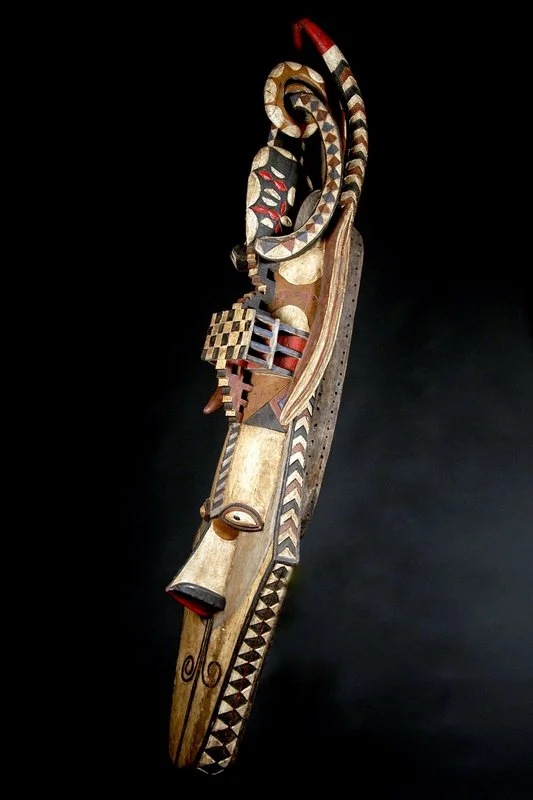Banda Mask
Baga/Nalu Mask (Banda)
Guinea
Prior to 1958
Wood. Dimensions: 96 x 16 in
Price: $200,000
Description
The Baga peoples are an ethnic group originally spread along the coasts of Guinea in small villages comprised of several clans or families. Particularly in areas around modern cities like Conakry and Boke, the Baga are ethnically diluted, and at least since the beginning of the twentieth century, outside influences have repressed and deformed original tribal practices. The coast of Guinea is a maze of swamps and lowlands which seem to have insulated the Baga from the earliest predations of colonialism; and their deeper cultural history puts their origins in the highlands of the Guinea interior from which they made an exodus, possibly in the 16th century, under pressure from other, better-armed groups. From these various pressures sprang a rich and varied spiritual/artistic vocabulary which remains intact into the present.[1]
While rituals may vary between regions, Baga ceremony and artistic expression are unified by a strong animist mythology and symbology which seek to control the essential balance between opposing natural forces: male and female, beginnings and endings, good and evil; as well as the maintenance of hierarchies within a village. During ceremonies their masks and figures both represent and are imbued with a myriad of spirit deities who help regulate everything: birth, death, marriage, initiation, agriculture, fertility, harmony between neighbors, and evil presences.[2]
“The character Banda, also called Kumbaruba by some Baga groups, has a long, horizontal headdress composed of the jaw of a crocodile, the face of a human being (with Baga scarification marks and a woman’s elaborately braided coiffure), the horns of an antelope, the body of a serpent, and the tail of a chameleon . . . The art of transformation is clearly at the heart of the Banda masquerade . . . Banda . . . fulfill the serious ritual function of movement between the natural and the physical world, and between distinct natural forms.”[3]
The Banda mask is agreed to be a multi-functional spirit, rather benign but quite powerful. Originally an extremely serious and sacred being, its festive character and available combinations with other masquerades has led, since the beginning of the 20th century, to a more public, accessible, and celebratory usage. Smaller Banda masks were used in village-wide masquerades as supporting figures for the Kumbaruba (the father), including Pende-Pende (a buffoon, or alternatively a policeman); to-Bon (the small one); and Dudu (role unexplained).[4]
Our example is an imposing 96” tall and reveals all the subtlety of the carver’s art. From the chin, a perimeter of black diamonds on a white background transform into black, red, and white chevrons before merging into elongated antelope horns banded in blue, white, and red. A long face, pronounced nose, and prominent forehead of kaolin establish uninterrupted fields of white to contrast with the busy geometry and colorful carvings of the headdress and elegantly crafted coiffure at the top. Polychrome details are beautifully preserved and exhibit the care exercised by the original collector during the years of this piece’s long journey from hidden artifact to a return to the public eye.
![Mask, banda
Baga, Nalu, Landuma, or Susu, Guinea
Wood, pigment
Length: 141 cm [55.51 in]
Musée Barbier-Mueller
Inventory Number: 1001-24
(Photo: Studio Ferrazzini-Bouchet for Musée Barbier-Mueller. Published in: Martínez-Jacquet, Elena](https://images.squarespace-cdn.com/content/v1/65cac4c3ab3fa964279c3ac8/a279ac3b-9d9f-4c53-b748-bca047138947/Banda+Mask+Museum+Comp+1+Barbier-Mueller.png)
Mask, banda
Baga, Nalu, Landuma, or Susu, Guinea
Wood, pigment
Length: 141 cm [55.51 in]
Musée Barbier-Mueller
Inventory Number: 1001-24
(Photo: Studio Ferrazzini-Bouchet for Musée Barbier-Mueller. Published in: Martínez-Jacquet, Elena. “So Familiar, So Mysterious: The Art of the Baga of Guinea at the Musée Barbier-Mueller in Geneva” Tribal Art: Quarterly Journal of the Art Culture and History of Traditional Peoples and New World Civilizations 18 (1), no. 70 (Winter 2013): 70.)
Headdress (Banda)
Baga/Nalu, Guinea/Guinea-Bissau
Early 20th century
Wood, pigment, iron
Dimensions: 63 x 18.125 x 12 in
The Baltimore Museum of Art
Object Number: 1990.2
(Photo: The Baltimore Museum of Art. Published in: “New Acquisitions.” African Arts 24, no. 1 (1991): 82.)
Mask (Banda)
Nalu peoples, Guinea, Niger River region
19th - 20th century
Wood, paint; raffia and textile attachments reconstructed 1995
Dimensions: 25.4 × 32.5 × 133.5 cm [10 x 12.8 x 52.56 in]
The Metropolitan Museum of Art
Accession Number: 1978.412.307
(Photo: The Metropolitan Museum of Art)
Provenance
A collection of Baga pieces collected by Baba Keita, Abidjan, Ivory Coast before 1958. Sold to our collector in Sarasota, FL in 2003.
From a collection of Baga pieces collected by Baba Keita before 1958 and held in storage by him and later by his brother Adama Keita until 2003 in Guinea. Extensive documentation of the collection purchase and transfer can be seen here.
Lamp, Frederick. Art of the Baga: A Drama of Cultural Reinvention. New York: Prestel, 1996.
Martínez-Jacquet, Elena. “So Familiar, So Mysterious: The Art of the Baga of Guinea at the Musée Barbier-Mueller in Geneva.” Tribal Art: Quarterly Journal of the Art Culture and History of Traditional Peoples and New World Civilizations 18 (1), no. 70 (Winter 2013): 68–71.
“New Acquisitions.” African Arts 24 (1) (January 1991): 82.
Robbins, Warren M., and Nancy Ingram Nooter. African Art in American Collections. Washington and London: Smithsonian Institution Press, 1989.
Schädler, Karl-Ferdinand. Encyclopedia of African Art and Culture. Munich: Panterra, 2009.
Schmalenbach, Werner, ed. African Art: From the Barbier-Mueller Collection. Munich: Prestel, 1988.
Siegmann, William C. African Art: A Century At The Brooklyn Museum. First Edition. Brooklyn, NY : Munich; New York: Prestel, 2009.
Visona, Monica Blackmun, Robin Poynor, Herbert M. Cole, Michael D. Harris, Rowland Abiodun, and Suzanne Preston Blier. A History of Art in Africa. New York: Prentice Hall/Harry N. Abrams, 2000.



![Mask (Banda)
Nalu peoples, Guinea, Niger River region
19th - 20th century
Wood, paint; raffia and textile attachments reconstructed 1995
Dimensions: 25.4 × 32.5 × 133.5 cm [10 x 12.8 x 52.56 in]
The Metropolitan Museum of Art
Accession N](https://images.squarespace-cdn.com/content/v1/65cac4c3ab3fa964279c3ac8/9fa89709-e626-4f81-910d-aa0c564830d8/Banda+Mask+Museum+Comp+3+Metropolitan+Museum+of+Art.jpg)